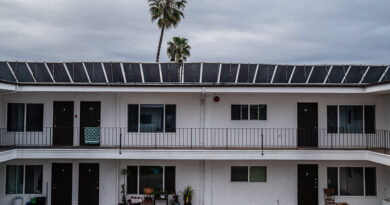Daily Business Report-Oct. 12, 2015
Rendering of the exteriof of The Park, a condo development planned for Bankers Hill.
Financing Arranged for 13-Story
Condominium Project on Bankers Hill


Zephyr Partners and LLJ Ventures have secured new joint venture equity financing of $39.7 million for the construction of a 13-story, 60-unit for-sale condominium project in San Diego’s Bankers Hill neighborhood.
“A true luxury condominium project in an urban setting simply hasn’t existed in San Diego until now,” said Brad Termini, co-founder of Zephyr Partners. ‘This project will fill a major void in the marketplace, and is garnering tremendous interest. We have already secured a dozen initial deposits for units at pro-forma prices.”
Zephyr Partners began its work on the entitlements and acquisition of the development site in October 2013, and LLJ Ventures become the joint venture partner for the development in August 2014. Together, Zephyr Partners and LLJ Ventures acquired the land in January 2015 and have been preparing the site for vertical construction.
The Park, as the project will be called, will have 21 three-bedroom residences, 39 two-bedroom residences, four penthouses, six townhomes and two guest suites. Two ground-level retail spaces will total 4,317 square feet.
Residents will have access to on-site amenities including a swimming pool and spa, fitness center, yoga studio, outdoor lounge area and a club room with a kitchen for hosting and catering events.
George Smith Partners secured the joint venture equity financing for the development.
________________________________________________________

State Department Clears Spain’s
Purchase of General Atomics’ Reaper
The U.S. State Department has approved Spain’s request to purchase four General Atomics-built Reaper unmanned aerial vehicles and associated equipment from the U.S. under a $243 million foreign military sale.
The Defense Security Cooperation Agency said that in addition to the systems themselves, the sale would include 20 Embedded Global Positioning System/Inertial Guidance United (three per aircraft plus eight spares); two Mobile Ground Control Stations; five multi-Spectral Targeting Systems (one per aircraft plus one spare); and five Synthetic Aperture Radar, Lynx AN/APY-8 (also one per aircraft plus a spare).
“The Spanish Air Force intends to use the MQ-9s for homeland security, peacekeeping, peace enforcement, counterinsurgency and counter-terrorism operations,” according to the solicit posted on the Defense Security Cooperation Agency’s website. “The proposed sale improves Spain’s ability to meet current and future threats by providing improved ISR coverage that promotes increased battlefield situational awareness, anticipates enemy intent, augments combat search and rescue, and provides ground troop support.”
Spain intends to use the drones purely for ISR, so the vehicles will not be armed.
Although the notice that the State Department has cleared the sale was posted on the DSCA’s website, that does not mean the sale has been completed. Congress must still OK it, and then a contract must be drawn up and finalized.
Spain also requested logistics services, program support and personnel training.
Metropolitan Water District Owes
Water Authority $43 Million More
A San Francisco Superior Court judge ruled Friday that the Metropolitan Water District of Southern California owes the San Diego County Water Authority $43.4 million in prejudgment interest, in addition to the $188.3 million awarded on Aug. 28 as contract damages for illegal rates MWD charged from 2011 to 2014.
The order brings the amount MWD owes the Water Authority to $231.7 million.
Judge Curtis E.A. Karnow ruled that the Water Authority is entitled to 10 percent interest annually on money that MWD overcollected, applying the mandatory prejudgment interest rate set by the state Legislature to encourage defendants to pay their debts on time. The post-judgment interest rate is 7 percent annually, meaning the total amount due to the Water Authority under the court’s final judgment will continue to grow until MWD pays what it owes.
MWD argued it owed only $4.16 million in prejudgment interest; the Water Authority argued it was owed $43.4 million. Judge Karnow awarded $43,415,802. Added to the damages Judge Karnow awarded in August, this fixes the final judgment amount at $231,711,404. Under state law, this amount will accrue 7 percent interest annually until MWD pays the judgment.

Highest Achieving Freshman
Class in San Diego State History
The new crop of freshmen at San Diego State University is again the highest-achieving in the history of the university.
Classes began on Aug. 24, but a complete census could not be taken until after the final add/drop deadline. Final numbers show that among the 5,142 first-time freshmen at the San Diego campus, the average high school GPA remained steady at 3.69 with an average SAT score of 1118, up from 1115 the year before.
The incoming class is also highly diverse: 52.9 percent of first-time freshmen on campus are students of color and 54.8 percent are women.
“Each year the academic strength of SDSU’s incoming students is more impressive than the year before,” said SDSU Provost and Senior Vice President Chukuka S. Enwemeka. “It’s exciting to see all of the hard work that has gone into the university’s strategic plan coming to fruition as we continue to advance student success, diversity and academic quality.”
SDSU’s one-year continuation rates also continue to climb with 89.8 percent of full-time freshmen from the 2014/15 academic year returning to campus, up from 88.2 percent for the 2013/2014 academic year.
The application pool was more competitive than ever before, with a record 82,000 undergraduate applications received for the 2015/16 academic year.
SDSU also welcomes 2,096 new graduate students, including 373 post baccalaureate students, 1,586 master’s students and 137 doctoral students. The class includes three National Science Foundation Fellows, four international Fulbright Fellows, five campus Fulbright Fellows and 20 Presidential Graduate Research Fellows.
Congresswoman Susan Davis
Hosts College Affordability Forum
Congresswoman Susan Davis (D-San Diego) will host a forum on college affordability on Tuesday, Nov. 10 from 6 to 8:30 p.m. at Griffin Gate on the Grossmont College campus in El Cajon. Experts on higher education and financial aid will be present.
“Students as well as parents are feeling the weight of mounting student loan debt and the rising cost of college,” said Davis, a senior member of the House Committee on Education and the Workforce. “There are legislative solutions that Congress must address, but we can also provide people with information on how to manage debt and pitfalls to avoid.”
Representatives from the Department of Education and financial aid officers from local colleges will be on hand to answer questions about the Free Application for Federal Student Aid (FAFSA) and responsible loan ownership. A Legal Aid Society lawyer will discuss student consumer rights. Registration for the event begins at 6 p.m.
Space is limited. Attendees are asked to RSVP at
http://susandavis.house.gov/college-affordability-forum
Student loan debt has reached $1.2 trillion. That’s more than credit card debt and auto loan debt. It works out to an average of $28,000 per borrower with an average of 13.4 years to pay off a student loan debt.
San Diego Regional Plan
Adopted by SANDAG Board
The SANDAG Board of Directors voted unanimously Friday to adopt the final version of San Diego Forward: The Regional Plan, a blueprint for the future that will invest $204 billion into transportation infrastructure projects over the next 35 years.
San Diego Forward lays out a vision to address the region’s current and future transportation needs, including specific plans to help realize that vision by investing in transit projects, bikeways, pedestrian improvements, and a Managed Lanes network (lanes the accommodate carpools and transit, and sometimes toll-paying solo drivers) between now and 2050.
The plan:
• Commits more than 50 percent of its $204 billion investment to transit, including five new Trolley lines, 32 new Rapid lines, and significant increases in transit frequencies.
• Dedicates 15 percent of its resources to add 160 miles of Managed Lanes to our existing freeways for the specific purpose of allowing transit, carpools, and vanpools to be more efficient and bypass traffic.
• Directs more than $588 million to building 275 miles of bikeways, making active transportation a realistic alternative to car travel for more people.
• Invests a total of $4.9 billion in active transportation improvements throughout the region, including biking and walking improvements
The Environmental Health Coalition criticized the plan, saying it ignores years of community requests for prioritized improvements to transit, biking and walking infrastructure. It claimed the plan jeopardizes the health and safety of resident in low-income communities and keeps San Diego from meeting its Climate Action Plan goals.

San Diego Mesa College Awarded
Orchid for Landscape Architecture
The San Diego Architectural Foundation honored San Diego Mesa College for outstanding landscape architecture at its annual Orchids & Onions awards ceremony on Oct. 1. The college’s $109.3 million, four-story Math+Science Complex received an Orchid Award for its exterior landscaping, designed to be used for instruction in biology and the physical sciences.
The Math+Science Complex includes three drought-tolerant, globally-themed gardens: an Australian, South African, and San Diego native garden. A “geo garden” in the structure’s north courtyard features three, six-foot-tall stone wall segments that depict the earth’s layers. San Diego Mesa College has already received numerous accolades for new construction throughout the campus from organizations like the American Society of Landscape Architects, the American Institute of Architecture, the American Public Works Association, and the Construction Management Association of America.
Sequenom to Collaborate on Liquid
Biopsy with German University
San Diego-based Sequenom will collaborate with the University Medical Center Hamburg-Eppendorf in Germany to evaluate the clinical utility of a liquid biopsy assay in colorectal cancer, the firm said today.
Sequenom is currently developing a circulating tumor DNA research assay with an initial focus on the detection and molecular profiling of late stage non-hematologic malignancies in cases where tissues biopsies are not available or are too risky to obtain.
In collaboration with Germany’s UKE, Sequenom will test the assay’s ability to monitor response to treatment in later-stage colorectal cancer patients. UKE has been studying ctDNA and circulating tumor cells for years and is currently involved in a number of different clinical studies, Klaus Pantel, chairman in the department of tumor biology at UKE’s Center of Experimental Medicine, said in a statement. The Sequenom collaboration will “allow us to qualitatively and quantitatively evaluate somatic mutations in the blood of colorectal cancer patients, and monitor response to treatment in a non-invasive manner,” he said.
Daniel Grosu, Sequenom’s chief medical officer, said in a statement that the study with UKE will help “better understand the dynamic changes in circulating tumor DNA that accompany the use of various treatments in later-stage colorectal cancer, and the concordance between tumor tissue and plasma across a broad spectrum of genomic alterations.”


